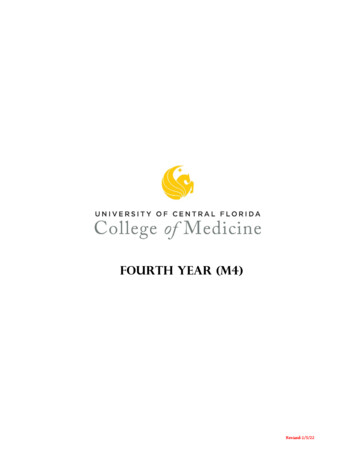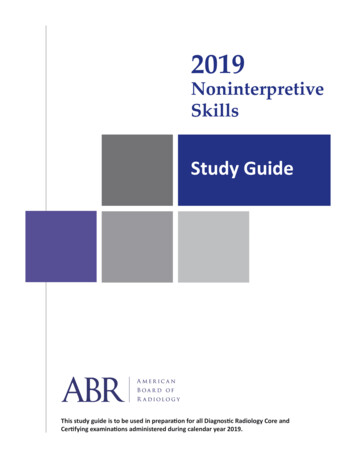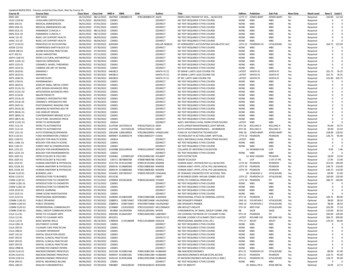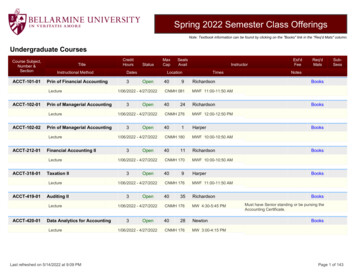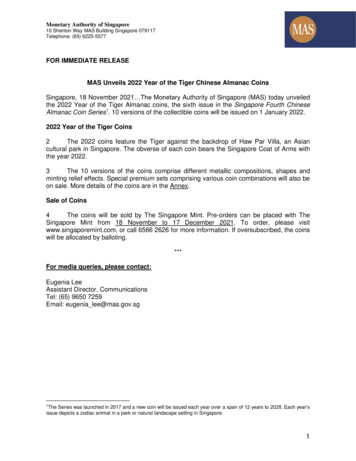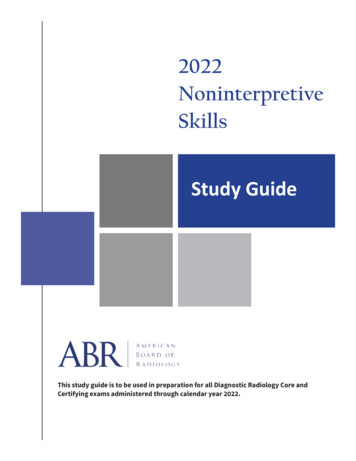
Transcription
2022NoninterpretiveSkillsStudy GuideThis study guide is to be used in preparation for all Diagnostic Radiology Core andCertifying exams administered through calendar year 2022.
Table of ContentsIntroduction .4Chapter 1. Core Elements of Professionalism .51.1 ABIM Physician Charter for Medical Professionalism in the New Millennium . 51.2 Ethical Considerations Specific to Radiology. 7Chapter 2. Core Concepts of Quality and Safety .92.1 Core Concepts of Quality. 92.1.1 Introduction to Quality . 92.1.2 Quality as a Discipline . 92.1.3 2001 Institute of Medicine Report, Crossing the Quality Chasm . 102.1.4 Core Competencies of the ABMS and ACGME . 112.2 Core Concepts of Safety . 122.2.1 2000 Institute of Medicine Report, To Err is Human . 122.2.2 2015 Institute of Medicine Report, Improving Diagnosis in Health Care . 122.2.3 Human Factors. 142.2.4 Human Error . 162.2.5 Culture of Safety . 16Chapter 3. Practical Quality and Safety Applications in Healthcare . 203.1 Practical Quality Applications in Healthcare . 203.1.1 Daily Management Systems . 203.1.2 Project-based Improvement Methods . 213.2 Practical Safety Applications in Healthcare . 273.2.1 Periprocedural Care . 273.2.2 Hand Hygiene. 303.2.3 Root Cause Analysis . 31Chapter 4. Practical Safety Applications in Radiology . 334.1 MR Safety . 334.1.1 Zoning and Screening . 334.1.2 Implanted Devices . 354.1.3 MR and Pregnancy . 364.1.4 MR-induced Burns . 364.1.5 Quenching. 374.2 Management of Intravascular Contrast Media . 374.2.1 Iodinated Contrast Media. 374.2.2 Gadolinium-based Contrast Media (GBCM) . 454.2.3 Treatment of Acute Contrast Reactions . 49Chapter 5. Reimbursement, Regulatory Compliance, and Legal Considerations in Radiology . 535.1 Reimbursement and Regulatory Compliance. 535.1.1 Coding, Billing, and Reimbursement . 535.1.2 Patient Privacy and HIPAA . 555.1.3 Human Subjects Research . 565.2 Malpractice and Risk Management . 575.2.1 General Principles of Malpractice . 575.2.2 Malpractice Related to Diagnostic Errors . 585.2.3 Malpractice Related to Procedural Complications . 592022 Noninterpretive Skills Study Guide2
5.2.4 Malpractice Related to Communications Deficiencies . 595.2.5 Discoverability of Communications . 62Chapter 6. Core Concepts of Imaging Informatics . 636.1 Standards . 636.2 The Reading Room Environment. 636.3 From Order to Report: Workflow Considerations . 656.4 Data Privacy and Security . 656.5 Image Post-processing and Artificial Intelligence . 666.6 Image Artificial Intelligence . 662022 Noninterpretive Skills Study Guide3
IntroductionThis study guide has been created to assist examinees in preparing for the noninterpretive skills (NIS)section of the American Board of Radiology (ABR) Core and Certifying exams administered throughcalendar year 2022.The guide has undergone a few changes compared to the 2021 version. The primary changes in thisversion are the expansion of Artificial Intelligence concepts in Informatics and additional content ondecision support to the regulatory chapter. Details of contrast safety and MR safety have also beenupdated, reflecting new published guidelines.The determination of whether specific NIS topics merit inclusion in the study guide—and on theexams—is based primarily on two factors. First, material contained in the NIS section should reflectknowledge that is needed to perform effectively in a modern radiology practice. Second, the publicinterest should be served by expecting the examinee to know the material.Core Elements of Professionalism were deemed to merit inclusion because they reflect basic principlesto which all physicians, including radiologists, should adhere. Core Concepts of Quality and Safetywere included because they reflect underlying principles that drive quality and safety in any complexenvironment. Practical Quality and Safety Applications in Healthcare contain quality and safetystrategies as they are applied to healthcare. Practical Safety Applications in Radiology focus onradiology-specific topics such as MR safety and management of intravenous contrast material.Reimbursement, Regulatory Compliance, and Legal Considerations in Radiology reflect mechanismsthat external parties use to ensure quality and safety in radiology practice. Informatics and artificialintelligence represent a growing area where knowledge is integral to the modern practice of Radiology.The guide covers the majority of general conceptual and practical NIS information contained in theCore and Certifying exams. However, questions on important subspecialty-specific quality and safetyknowledge and skills are also included on the exams that are not included in this guide, especiallythose related to nuclear medicine and other procedure-based specialties. Examinees should beknowledgeable in basic quality and safety practices relevant to all subspecialties regardless of whetherthey are included in this study guide. Physics topics, including radiation safety, are on the exam butnot included in the NIS section.Examinees are expected to understand general NIS concepts rather than esoteric details. For example,examinees should understand regulatory requirements that are relevant to daily radiology practice, aswell as their underlying purpose. Less emphasis is placed on more superficial details, such as thenames of the various regulatory agencies.This study guide will continue to evolve in future years to reflect continuing changes in the noninterpretive knowledge and skills needed to practice effectively in a modern radiology practice.We also draw your attention to the references provided at the end of each chapter. We recommend thatyou consult these “deeper” resources, which provide perspective and depth of understanding of theconcepts that are only superficially outlined in this study guide.2022 Noninterpretive Skills Study Guide4
Chapter 1: Core Elements of Professionalism1.1 ABIM Physician Charter forMedical Professionalism in the NewMillenniumMerriam-Webster defines a profession as “acalling requiring specialized knowledge andoften long and in- tensive academicpreparation.” Professionalism, defined as “theconduct, aims, or qualities that characterize ormark a profession or a professional person,”has been characterized as the basis ofmedicine’s contract with society. Severalfundamental principles and physicianresponsibilities that apply to all professionals inmedicine have been specified in a PhysicianCharter supported by the American Board ofInternal Medicine (ABIM). Ten professionalresponsibilities support the following threefundamental principles of medicalprofessionalism:1. Principle of primacy of patient welfare.Physicians must be dedicated to servingthe interest of the patient. Trust iscentral to the physician-patientrelationship, which must not becompromised by market forces, societalpressures, or administrative exigencies.2. Principle of patient autonomy.Physicians must be honest with theirpatients and empower them to makeinformed decisions about theirtreatment. Patients’ decisions abouttheir care must be paramount, as long asthey are in keeping with ethical practiceand do not lead to demands forinappropriate care.3. Principle of social justice. The medicalprofession must promote the fair2022 Noninterpretive Skills Study Guidedistribution of healthcare resources.Physicians should work actively toeliminate discrimination in healthcare.The 10 professional responsibilities aresummarized below:1. Commitment to professionalcompetence. Physicians must becommitted to lifelong learning ofmedical knowledge and team skillsnecessary for the provision of qualitycare. More broadly, the profession as awhole must strive to see that all of itsmembers are competent and mustensure that appropriate mechanisms areavailable for physicians to accomplishthis goal.2. Commitment to honesty with patients.Physicians must ensure that patients arecompletely and honestly informedbefore the patient has consented totreatment and after treatment hasoccurred. Medical errors should becommunicated promptly to patientswhenever injury has occurred.Physicians should be committed toreporting and analyzing medicalmistakes to develop appropriateprevention and improvement strategies.3. Commitment to patient confidentiality.Physicians are responsible forsafeguarding patient information.Fulfilling this commitment is morepressing now than ever before, giventhe widespread use of electronicinformation systems. However,considerations of public interest mayoccasionally override this commitment,5
such as when patients endanger others.4. Commitment to maintainingappropriate relations with patients.Given the inherent vulnerability anddependency of patients, certainrelationships between physicians andpatients must be avoided. In particular,physicians should never exploit patientsfor any sexual advantage, personalfinancial gain, or other private purpose.5. Commitment to improving quality ofcare. Physicians should not onlymaintain clinical competence, butshould work collaboratively with otherprofessionals to continuously improvethe quality of healthcare, includingreducing medical errors, increasingpatient safety, improving utilization ofhealthcare resources, and optimizingoutcomes of care.6. Commitment to improving access tocare. Physicians should workindividually and collectively towardproviding a uniform and adequatestandard of care and reducing barriersto equitable healthcare. These barriersmay be based on education, laws,finances, geography, or socialdiscrimination. This commitment entailsthe promotion of public health andpreventive medicine, withoutpromotion of the self-interest of thephysician or the profession.7. Commitment to a just distribution offinite resources. To provide costeffective health care, physicians shouldwork with other physicians, hospitals,and payers to develop evidence-basedguidelines for effective use of healthcareresources. This includes the scrupulousavoidance of superfluous tests andprocedures to reduce patient exposure2022 Noninterpretive Skills Study Guideto harm, decrease health expenses, andimprove access to resources for patientswho need them.8. Commitment to scientific knowledge.Physicians should uphold scientificstandards, promote research, and createnew medical knowledge and ensure itsappropriate use. The integrity of thisknowledge is based on scientificevidence and physician experience.9. Commitment to maintaining trust bymanaging conflicts of interest. Medicalprofessionals and organizations cancompromise their professionalresponsibilities by pursuing private gainor personal advantage, especiallythrough interactions with for-profitcompanies. Physicians have anobligation to recognize, disclose to thegeneral public, and deal with conflicts ofinterest that arise in the course of theirprofessional duties and activities.Relationships between industry andopinion leaders should be disclosed,especially when physicians aredetermining criteria for conducting andreporting clinical trials, writingeditorials or therapeutic guidelines, orserving as editors of scientific journals.10. Commitment to professionalresponsibilities. Physicians have bothindividual and collective obligations towork collaboratively to maximizepatient care, be respectful of oneanother, and participate in the processesof self-regulation, including remediationand discipline of members who havefailed to meet professional standards.The profession should also define andorganize the educational and standardsetting process for current and futuremembers. These obligations include6
engaging in internal assessment andaccepting external scrutiny of all aspectsof their professional performance.1.2 Ethical Considerations Specific toRadiologyThe ABIM professional responsibilities largelyoverlap with the Code of Ethics as described inthe American College of Radiology (ACR)Bylaws. However, several principles and rulesof ethics apply specifically to the field ofradiology, as stated by the ACR.1. Professional limitations. The Bylawsstate that radiologists should be awareof their limitations and to seekconsultations in clinical situations whereappropriate. Any limitations should beappropriately disclosed to patients andreferring physicians.2. Reporting of illegal or unethicalconduct. To safeguard the public andthe profession against physiciansdeficient in moral character orprofessional competence, radiologistsare expected to report any perceivedillegal or unethical conduct of medicalprofessionals to the appropriategoverning body.3. Report signature. Radiologists shouldnot sign a report or claim attribution ofan imaging study interpretation thatwas rendered by another physician,making the reader of a report believethat the signing radiologist was theinterpreter.4. Participation in quality and safetyactivities. Radiologists who activelyinterpret images should participate inquality assurance, technologyassessment, utilization review, and2022 Noninterpretive Skills Study Guideother matters of policy that affect thequality and safety of care.5. Self-referral. Referring patients tohealthcare facilities in whichradiologists have a financial interest isnot in the best interest of patients andmay violate the Rules of Ethics.6. Harassment. Radiologists are expectedto relate to other members of thehealthcare team with mutual respectand refrain from harassment or unfairdiscriminatory behavior.7. Undue influence. Radiologists shouldseek to ensure that the system ofhealthcare delivery in which theypractice does not unduly influence theselection and performance ofappropriate available imaging studies ortherapeutic procedures.8. Agreements for provision of highquality care. Radiologists should notenter into an agreement that prohibitsthe provision of medically necessarycare or that requires care at belowacceptable standards.9. Misleading billing arrangements.Radiologists should not participate inbilling arrangements that misleadpatients or payers concerning the feescharged.10. Expert medical testimony. Radiologistsshould exercise extreme caution toensure that the testimony provided isnonpartisan, scientifically correct, andclinically accurate. Compensation that iscontingent upon the outcome oflitigation is unacceptable.11. Research integrity. Radiologic researchmust be performed with integrity andbe honestly reported.7
12. Plagiarism. Claiming others’ intellectualproperty as one’s own is unethical. Thisincludes plagiarism or the use of others’work without attribution.13. Misleading publicizing. Radiologistsshould not publicize themselvesthrough any medium or forum of publiccommunication in an untruthful,misleading, or deceptive manner.References1. American Board of Internal MedicineFoundation. Medical Professionalism in theNew Millennium: The Physician Charter.American Board of Internal MedicineFoundation Website. ter. Accessed October 1, 2016.2. American College of Radiology. Code ofEthics. American College of RadiologyWebsite. https:// Ethics. Accessed June 13, 2018.2022 Noninterpretive Skills Study Guide8
Chapter 2: Core Concepts of Quality and Safety2.1 Core Concepts of Quality2.1.1 Introduction to QualityMerriam-Webster defines quality as “a highlevel of value or excellence.” The Institute ofMedicine has defined quality of care as “thedegree to which health services for individualsand populations increase the likelihood ofdesired health outcomes and are consistentwith current professional knowledge.” As itrelates to diagnostic imaging and image-guidedtreatment, quality can be considered to be “theextent to which the right procedure is done inthe right way, at the right time, and the correctinterpretation is accurately and quicklycommunicated to the patient and referringphysician. The goals are to maximize thelikelihood of desired health outcomes and tosatisfy the patient.”Several important concepts are connected tothese statements.First, quality has two important dimensions:excellence and consistency. It is not enough toprovide excellent care; it must be done on aconsistent basis. Lack of consistency is a markerof poor quality.Second, performance must be monitored toensure consistent quality. It is unlikely for anorganization to achieve consistent excellentperformance in the absence of performancestandards or measurements.Third, the goals are twofold: 1) maximize thelikelihood of health outcomes desired by thepatient and 2) satisfy the patient. In otherwords, optimizing health outcomes and patientexperience are both important goals ofhealthcare. Furthermore, while excellence maybe a subjective term, the ultimate arbiter of2022 Noninterpretive Skills Study Guide“quality” is the patient. Those who wish toprovide quality care must understand and seekto achieve consistent excellence from theperspective of the patient—which may differfrom that of the provider.Fourth, the goal is to consistently achievedesired health outcomes using methods that areconsistent with current professionalknowledge. Achieving excellent outcomes on aconsistent basis depends on consistency in themethods, or processes, that are used to achievethose outcomes. Therefore, a major goal ofquality is that of decreasing unnecessaryvariation, both in processes and outcomes. In apractice with multiple professionals, thisgenerally requires those professionals tocollaborate in developing and adhering topractice standards based on the evidence.2.1.2 Quality as a DisciplineAchieving consistent excellence in processesand outcomes is challenging in healthcare,including in radiology. However, healthcare isby no means the only field in which consistentexcellence is desired. Over the past century,“quality” has emerged as its own discipline ofstudy and practice, with a set of broadlyapplicable definitions, principles, and tools.Quality control (QC) refers to measuring andtesting elements of performance to ensure thatstandards are met and correcting instances ofpoor quality. An example of a QC activity iswhen a radiologist reviews and corrects errorsin a radiology report before finalizing it.Quality assurance (QA) refers to a process formonitoring and ensuring performance qualityin an organization. This includes QC activities,but also refers to strategies designed to preventinstances of poor quality. An example of a QA9
activity is the use of standardized reporttemplates to minimize errors in reportingaccompanied by verification of appropriate usewith audit-based performance metrics.Quality improvement (QI) refers to activitiesdesigned to improve performance quality in anorganization in a systematic and sustainableway. This requires a deliberate effort within anorganization to agree on a measurableperformance objective, measure the relevantperformance, understand the causes of poorperformance, develop and implement strategiesto improve performance, and ensure that thosestrategies are embedded in the organizationsuch that performance will not relapse. Anexample of QI is a project whereby radiologistsagree to improve consistency in reporting usingstandardized radiology report templates,implement those templates, monitor radiologyreports and make necessary adjustments, andensure that consistency is maintained throughfeedback and accountability.QC is generally considered to be the most basiclevel of quality-related activities in anorganization. QA is more comprehensive thanQC and is required to maintain consistentlyhigh performance levels in an organization.However, QA typically is designed to maintainrather than improve performance, implyingthat quality was presumed to be adequate inthe first place. QI, on the other hand, assumesthat quality is not as good as it could be andemploys strategies to successfully improvequality through a variety of means, includingchanges in processes, systems, and evenorganizational structure. As organizations’focus has transitioned in recent decades fromseeking to maintain the status quo to seeking toconstantly improve performance, the field ofquality has transitioned from relying solely on aQA approach to one of continuous qualityimprovement (CQI).2022 Noninterpretive Skills Study GuideQuality methods and philosophies haveevolved in several other important ways in thepast several decades: Rather than being solely the purview ofa “quality department,” quality hascome to be recognized as theresponsibility of everyone in theorganization—especially organizationalleaders. The focus has shifted from detectingand correcting errors that have alreadyoccurred to improving processes andsystems to prevent errors fromhappening or from causing harm. Frontline staff are increasingly engagedto help improve processes. The value of making errors visiblerather than quietly fixing them withoutsharing them with the staff isincreasingly recognized. Exposingerrors allows them to be more easilydetected so they can be corrected andtheir causes addressed.2.1.3 2001 Institute of Medicine Report,Crossing the Quality ChasmIn 2001, the Institute of Medicine (IOM)published a report entitled, “Crossing theQuality Chasm: A New Health System for the21st Century.” In this report, the IOMcommittee members maintained that allhealthcare constituencies, includingpolicymakers, purchasers, regulators, healthprofessionals, health- care trustees andmanagement, and consumers, should committo a shared explicit purpose to continuallyreduce the burden of illness, injury, anddisability, and improve the health andfunctioning of the people of the United States.The committee asserted that healthcare shouldbe:10
Safe—avoiding injuries to patients fromthe care that is intended to help them. Effective—providing services based onscientific knowledge to all who canbenefit and refraining from providingservices to those not likely to benefit(avoiding underuse and overuse). Patient-centered—providing care that isrespectful of and responsive toindividual patient preferences, needs,and values and ensuring that patientvalues guide all clinical decisions. Timely—reducing waits and potentiallyharmful delays for both those whoreceive and those who give care. Efficient—avoiding waste, in particularwaste of equipment, supplies, ideas, andenergy. Equitable—providing care that does notvary in quality because of personalcharacteristics.and assimilate scientific evidence, andimprove the practice of medicine. Patient Care and Procedural Skills: Providecare that is compassionate, appropriate,and effective treatment for healthproblems and promote health. Systems-based Practice: Demonstrateawareness of and responsibility to thelarger context and systems ofhealthcare. Be able to call on systemresources to provide optimal care (e.g.,coordinating care across sites or servingas the primary case manager when careinvolves multiple specialties,professions, or sites). Medical Knowledge: Demonstrateknowledge about established andevolving biomedical, clinical, andcognitive sciences and their applicationin patient care. Interpersonal and Communication Skills:Demonstrate skills that result ineffective information exchange andteaming with patients, their families,and professional associates (e.g.,fostering a therapeutic relationship thatis ethically sound; using effectivelistening skills with nonverbal andverbal communication; and workingboth as a team member and, at times, asa leader). Professionalism: Demonstrate acommitment to carrying outprofessional responsibilities, adhering toethical principles, and being sensitive todiverse patient populations.Since its publication, the IOM “Chasm” report,which was itself a follow-up to a 2000 IOMreport on medical error, has provided a roadmap for individuals and organizations inhealthcare to focus their improvement efforts.2.1.4 Core Competencies of the ABMS andACGMETo encourage active physician participation inadvancing the goals of continuousimprovement, in 1999 the Accreditation Councilfor Graduate Medical Education (ACGME) andthe American Board of Medical Specialties(ABMS), which is composed of subspecialtyboards including the American Board ofRadiology, described six core competencies thatall physicians should attain. Practice-based Learning and Improvement:Show an ability to investigate andevaluate patient care practices, appraise2022 Noninterpretive Skills Study GuideBy establishing this set of competencies, theACGME and ABMS assert that the skillsnecessary to effectively practice medicine in amodern complex healthcare environmentextend beyond the traditional
2022 Noninterpretive Skills Study Guide 4 Introduction This study guide has been created to assist examinees in preparing for the noninterpretive skills (NIS) section of the American Board of Radiology (ABR) Core and Certifying exams administered through calendar year 2022. The guide has undergone a few changes compared to the 2021 version.

